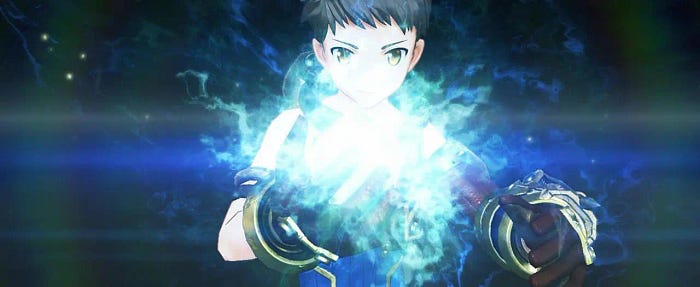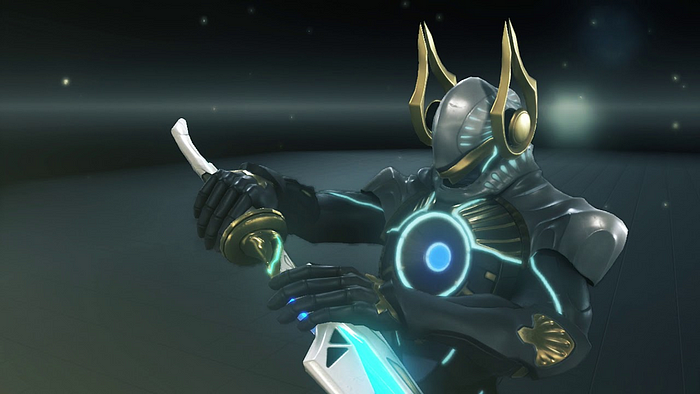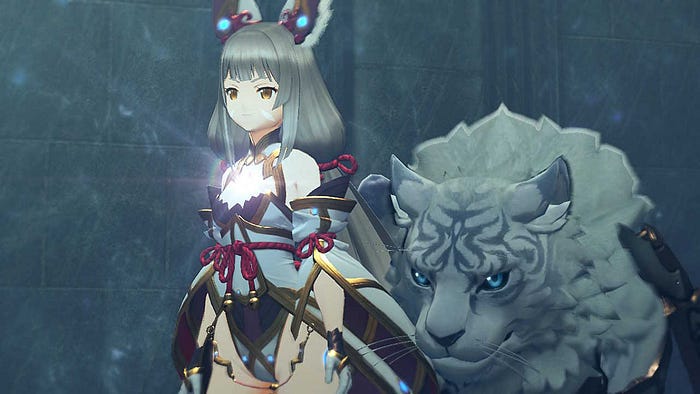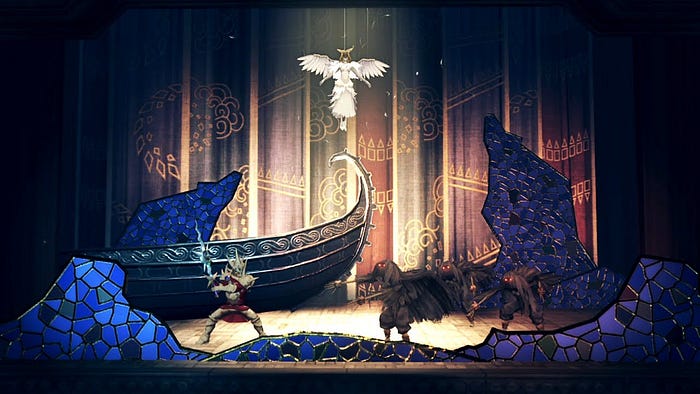
Content warning for discussions of indigenous genocide in Canada. In-depth content warnings and disclaimers can be found here. To briefly summarize, the purpose of this article is to explore historical events through the lens of narrative metaphors within Xenoblade Chronicles 2.
Links for further reading are included towards the end of the article as well, detailing in much more depth some of the histories I touch on here.
Spoilers for Xenoblade Chronicles 2’s entire plot, as well as portions of Xenoblade Chronicles 3’s plot.
Monolithsoft’s Xenoblade series is no stranger to references to Christian imagery. Many places, characters, and items within all of their games are named after real world Christian terminology or inspired by Christian stories and history. From the Monado in Xenoblade Chronicles 1 being named after Monad, the Supreme Being in Gnosticism, to the names of the three Trinity Processor cores in Xenoblade Chronicles 2 being derived from Greek terms for God, Jesus Christ, and the Holy Spirit, this series is rife with references, allusions, allegories, and influences from abrahamic religions.
However recently, while replaying Xenoblade Chronicles 2, I came to a realization that might go even deeper than just some allusions. It is not unknown that one of the primary villains Amalthus is a parallel for — and named after — Thomas Malthus, as well as the Catholic Church and its Pope, however the depth of this connection (to my knowledge) has not been touched on.
I’ve heard Thomas Malthus called the father of eugenics — the school of thought regarding selective breeding — and a founder of the population control philosophy “Malthusianism,” and this ideology can clearly be seen in the game, where Amalthus believes that the growth of humanity has led to its downfall.
However, his actions towards one of the game’s core races, Blades, reads like a metaphor-filled parallel to much of Indigenous History in Canada. The cleansing ritual, his desire for control over blades, and the disruption of a blade’s life cycle all feel like a strong metaphor for these experiences, and while the intent of the writers is unlikely, this essay seeks to explore those potential connections.
A glossary will be included at the bottom of the article for those who have not played Xenoblade Chronicles 2, or need a refresher on the terminology.
Amalthus’s Character and History

To start, Amalthus’s history, his character, and his actions must be addressed and brought into the open.
Amalthus acts as the Praetor for the Indoline Praetorium. His garb is quite similar (albeit more stylized) to Pope Francis’s own attire, and the attire past popes have worn. Similarly, he claims to be a prophet for the Architect, and that through him the Architect’s will may be executed.
Previous to his role as Praetor, he held the role of Quaestor in the Indoline Praetorium. At some point he sees the wars being waged, and in his frustration and anger for the human race, he climbs the World Tree into the mythical Elysium and seeks understanding from the Architect.
While there, he does not find the Architect. Instead, he finds two core crystals for two powerful Blades: Mythra and Malos. He himself awakens Malos, and Malos — inheriting some of Amalthus’s personality traits — begins to wreak havoc with the power he wields.
A war is waged, many lives are lost, and many citizens of fallen Titan continents are left as refugees either in Indol or elsewhere, even after Malos is defeated.
Much of this information is only important as context: one such continent that falls is Torna, a nation that is known for its respect and reverence of blades and titans. Tornans worship the cycle blades and titans exist in, and what it is representative of: a preservation of history, life, and existence itself.
After the Tornans are left as refugees, however, Amalthus usurps the title of Praetor, and leads an army of Indoline to kill and capture the surviving Tornans, starting the cycle of historical destruction that Blades have been victim to.
Amalthus’s Actions, and the Cycle of Blades and Titans

Using his power as Praetor, Amalthus commits a variety of different acts that oppress blades:
- He puts into effect a new order for each of the other nations: all core crystals must be diverted through Indol for cleansing for the purposes of easier resonance for more drivers.
- Cleansed core crystals are then redistributed around Alrest, seemingly at random.
- Utilizing control over the collection and distribution of almost all core crystals and blades across Alrest, Amalthus continues to suppress other nations — Tantal, most notably — in order to retain control over blades and their power.
The unconscious function of a blade’s core crystal, as explained by the game, is to collect the biological data of all life during their time bound to a driver, send that data to the Aegis cores to be processed when they return to their core, and then that data is sent back to the blade’s core crystal for reawakening. As the blade continues to collect, absorb, and process this data, their appearance and personality begins to grow and change with every new driver, taking on physical and emotional and functional traits of each new driver. When the blade’s core has collected and processed enough data, they become reborn as titans, and when those titans reproduce and die, they release new core crystals, continuing the cycle: the titans they give birth to will live, die, release their core crystal to become a blade, collect biological data as a blade, and be reborn as a titan again.
This process is one blades are unaware of, and a secret well-kept after Torna falls. As blades lose their experiential memory between lifetimes, they cannot continue to know their internal function.
There are ways to interrupt this cycle, and three are gone into in detail:
- Shattered Core Crystal: if a blade’s core crystal receives too much damage, the blade will return to their core crystal, never to be awakened again.
- Flesh Eating: the process of absorbing non-blade DNA into a blade’s core crystal, forgoing reincarnation in favour of prolonged existence beyond the driver’s death.
- Blade Eating: the process of a blade surgically separating a part of its core to be surgically installed into their driver, allowing their driver to live longer, but again forgoing reincarnation.
However, it is theorized that Amalthus’s cleansing ritual is another break in this cycle. It’s revealed late in the game that Amalthus’s cleansing ritual actually absorbs that biological data, interrupting it being returned to the Aegis cores for processing, and preventing the blades from growing biologically and eventually into titans. After Amalthus has wiped the core crystals of their collected data, they are then redistributed at random to different nations and drivers.
A line late in the game, spoken by another antagonist, Jin, speaks to this:
“We have no culture, because Indol decrees it.”
It’s believed that the common blades acquired throughout the game are blades that have received Amalthus’s cleansing and been redistributed throughout Alrest.

These blades follow a generic design of black, white, and blue chrome with randomized features such as horns, associated weapons, and names in order to set them apart from each other, as shown above.

Other blades (referred to as Rare and Legendary Blades by the game) have much more distinct features garnered from the history of their resonance. In Nia and Dromarch’s case (as shown above), it’s likely they draw their features and traits from the Gormotti race of humans (humans with cat-shaped ears), or other beasts and animals around the Gormott region. Additionally, these blades have much more personality, drive, and knowledge of themselves than common blades, traits acquired through repeated resonance, gaining of biological data, and being able to continue the cycle.
Connecting Fiction and History

Throughout all of Canada, indigenous peoples of the region have been persecuted, restricted, and had their very culture stolen from them by colonists from Britain. This information is incredibly well documented, and so I’d like to draw some lines between this history and what Xenoblade Chronicles 2 shows us.
Looking at purely artistic metaphors, the design of common blades, as well as their lack of accumulated personality and traits, could be a visual and narrative metaphor representative of indigenous children separated from their homes.
The absence of that history, of that knowledge of oneself, and of that knowledge of heritage caused by separating indigenous children from their homes and communities and culture is represented here, in these blades that are completely absent of history, of their previous reincarnations. That culture was stolen from them by British colonists, as the Blade’s history was stolen from them by Amalthus and Indol.
This theoretical connection is also backed up by the blades who have these connections, have this history, who are more full of personality and distinctive traits. These blades have had long lineages of reincarnation within their communities, likely having access to the oral history of their past selves. Brighid is a solid example of this, known for keeping a journal of her past lives that is very carefully protected by the Empire. Blades that undergo cleansing and redistribution by Indol have no access to their past, or can lose any efforts made to protect their past.
Similarly, indigenous groups who survived colonialism and were able to rebuild were able to protect parts of their cultures and oral histories to the best they could, and could trust that the people in their communities would continue to pass down this history to every new generation.
Common blades who have had their history severed from them by Amalthus also would naturally struggle to return to the communities they came from, as would the descendants of indigenous peoples disconnected from their heritage. Their histories were both taken from them, and unless they have people who can recognize them or guide them, they can forever struggle to find their past.
Looking even at the name of Amalthus’s ritual, The Cleansing Ritual, it’s hard not to draw connections to the residential schools that persisted until the late 20th century. The purpose of residential schools was to burn away, or “cleanse”, the inherited culture and practices of indigenous youth, as Amalthus burns away the history of the blades he “cleanses”. Amalthus claims that his ritual would allow these blades to be more easily bonded with, similar to how the advertised intent of residential schools is to help indigenous children integrate more easily with modern society. Instead, what is revealed towards the end of the story, is that Amalthus is trying steal this data for himself, believing he is an agent of the Architect, as residential schools were revealed to be terrible places intended to destroy indigenous culture so Catholicism and Christianity could continue to hold power.
And the way Indol redistributes blades — sending them randomly all over Alrest — draws connections to the Sixties Scoop, where Canadian indigenous youth were taken from their families and bands and put into either the child welfare system or are adopted by typically white Canadian families between 1961 and the 1980s. Furthermore, the lack of protection that these children faced after being redistributed is also represented in Xenoblade Chronicles 2, with how many drivers treat the blades they’ve received from Indol poorly.
Finally, as we know, Amalthus disrupts the cycle that blades are intended to uphold. By sapping the blade of its history and data, it can no longer grow into a titan for humanity to survive on the back of. With the way that colonisers disrupted and stole indigenous land, they disrupted the indigenous practices that were designed to protect and nourish the land they inhabited. And so, in both the story and real world history, land became scarce or unlivable. The titans started to die out with no titans to replace them; Biodiversity began to suffer, and natural disasters like forest fires became common, because the native population could not care for their land the way they had been for thousands of years.
The end of the story, and where we are now

Of course, not all is so terrible. While the history we look back on is important, it is also important to see the progress in front of us.
Xenoblade Chronicles 2’s story does not end with the blades continuing to exist under Indol’s control. It does not end with a continued cycle of destruction, dehumanization, and colonization. The history of indigenous genocide does not end this way either.
All throughout the main story of Xenoblade Chronicles 2, Jin, Malos, and their group of other mistreated flesh eater blades (known as Torna) are fighting against the work of Indol and its corruption. Blades that have experienced the control, oppression, and mistreatment of Indol, working together to overthrow it. And while their end goals and methods were severe, they still sought this justice for a good reason: to protect the blades like them, and rebuild their culture.
While Torna’s methods were violent, they were also part of a fictional tale. However, they also find similarities to real world rebellion: destruction of Indoline property and technology, and disruption of Indol trafficking blades and collecting core crystals, among other things.
In Canada’s history, there have been protests held by Indigenous peoples nationwide; most recently protesting the Westcoast Connector Gas Transmission, a pipeline that would run through 190km of unceded Wetʼsuwetʼen territory and cause harm to their native lands, however more and prominent protesting and rebellion has persisted for a very long time.
And by the end, Jin passes off the legacy of justice he has worked hard to achieve to Rex, the protagonist, and his friends, finally fulfilling the cycle that had been disrupted by Amalthus: The cycle of passing on motivations, history, and intentions. With the death of residential schools, and acts being put in place to protect indigenous peoples, indigenous culture has begun to grow and rebuild, being able to once again pass on motivations, history, and intentions to new generations. Indigenous people can feel comfort in knowing their torch will continue to be carried, that their fights will continue onward.
In the sequel, Xenoblade Chronicles 3, it’s shown that Nia, a blade that has hidden her identity through most of Xenoblade Chronicles 2 for fear of oppression, acts as the Queen of one of the in-game regions, and so presumably she’d also held some position of royalty between the end of Xenoblade Chronicles 2 and the start of Xenoblade Chronicles 3. This small detail shows that the torch Jin passed onto Rex was not snuffed out, but carried onward and onward until justice was obtained.
However, in our real world, we don’t know how the story ends. We don’t know if justice will be served, if the torch will burn on. But if recent history is indicative of anything, it’s that progress is being made. Resolving an over 150-year-long history of oppression and erasure will not happen overnight, and it won’t be clean or easy. But by supporting those who fight, or fighting alongside them, the progress that’s been made up to now can keep its momentum, and the torch can keep burning.
Should you, as the reader, believe there is anything incorrect or under-represented in this piece, or have any other feedback, please leave a comment on the piece or fill out this Google Form to ensure your feedback properly reaches me. Critique, feedback, and any other comments are welcomed and encouraged, especially given the subject matter to which I am speaking.
Further Reading:
- The Residential School System (Indigenous Foundations, UBC)
- History of Residential Schools (Indigenous Peoples Atlas of Canada)
- Sixties Scoop (Indigenous Foundations, UBC)
- Sixties Scoop Healing Foundation
- Indigenous Peoples Collection (The Canadian Encyclopedia)
- National Inquiry into Missing and Murdered Indigenous Women and Girls
- The Landback Movement
Glossary:
Terms used throughout the article that may not be understood.
- Praetorium: Allegory for the Catholic Church and Vatican City.
- Praetor: Old Roman term for a magistrate, here used as an allegory for the pope.
- Indol/Indoline: Nation in Xenoblade Chronicles 2 and its people. Indoline live very long lives, and are quite similar to fantasy elves.
- Quaestor: Old Roman term similar to treasurer, or secretary of finances.
- World Tree: A large tree existing in the centre of Alrest’s Cloud Sea, said to have Elysium at the top.
- Elysium: A mythical boundless land, as told in in-universe fairy tales and mythology. Allegory for Heaven, named after the highest layer of the Greek Underworld.
- Blades: A species of intelligent life in the world of Alrest, whose lives are bound to the one who awakens them from their Core Crystal. When the driver dies, a blade returns to their core crystal, waiting to be awakened again.
- Driver: One who awakens a core crystal into a blade, and is bound to the blade for the remnant of their life.
- Core Crystal: The form a blade takes when it has not been awoken, or when it returns to its core after its driver dies. Very literally a crystal that is the core of blades.
- Titans: Very large beasts that roam the Cloud Sea, housing humans on their backs. Some are much much bigger than others. The largest ones are considered continents.
- Alrest: The world Xenoblade Chronicles 2 takes place in.
- Cloud Sea: A literal sea of clouds, so thick it can be swam in.
- Common/Rare Blades: The way the game distinguishes between generic blades and stronger, more characteristic blades.
Edit — 16 June 2023: Added brief summary of intent in content warnings, slight change in language in introduction to signify that the connection was likely unintended from developers.
